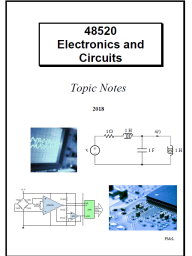Topic

Complete Topic Notes
The topic notes - an entry point into the vast literature on Electronics and Circuits - Contents, Topics 1 to 26, Matrices Guide and Exercise Answers
We will start by revising some basic concepts, such as KVL, KCL and Ohmís Law.
We introduce the concept of the electronic amplifier, and then study a device called an operational amplifier (op-amp for short), which has been used as the building block for modern analog electronic circuitry since its invention in the 1960ís.
This topic outlines the two most common (and useful) formal circuit analysis techniques. Nodal analysis is the most general, and is used to find all voltages in a circuit. Mesh analysis only applies to planar circuits, and is used to find currents in a circuit.
04 - Circuit Analysis Techniques
There are other circuit analysis techniques that we use all the time apart from nodal and mesh analysis. We will look at a few of the most important and practical ones.
05 - Linear Op-Amp Applications
The op-amp is a very versatile electonic building block. We will examine its use as a summer, subtractor, integrator, negative impedance converter and voltage-to-current converter.
06 - Reactive Components
The capacitor and the inductor are called reactive components - they are special circuit elements because they store energy. Practical capacitors and inductors can be modelled using ideal circuit elemnts. Duality plays an important role in analysing circuits.
07 - Diodes and Basic Diode Circuits
The diode is the simplest nonlinear circuit element, yet it can be used in a variety of practical applications. We need to understand its operation and extend our circuit analysis techniques to handle nonlinear circuit elements.
08 - Source-Free RC and RL Circuits
How does a capacitor discharge through a resistor? What happens when a magnetic field around an inductor collapses? To answer these questions, we need to examine source-free RC and RL circuits. We will see that the governing differential equations cause all voltages and currents to take a decaying exponential form. This is called the "natural response".
09 - Nonlinear Op-Amp Applications
The versatile op-amp is put to good use in creating circuits that would be otherwise unattainable with purely passive circuitry. We look at a few common applications, such as zero-crossing detection, level detection and precision rectification - just a taste of what is possible!
10 - The First-Order Step Respnse
For a simple RC circuit subjected to a "step input" (a DC voltage being switched on), we'll analyse it to find the describing differential equation, then go about solving the differential equation to establish the complete response. We'll then see that there is a general principle that allows us to find the complete response without solving differential equations - "the complete response is the forced response plus the natural response". We'll apply this approach to an RL circuit.
11 - Op-Amp Imperfections
12 - The Phasor Concept
Phasors are complex numbers that represent sinsuoids. Here we'll see how they can be used to simplify the analysis of circuits subjected to sinusoidal excitation.
13 - Circuit Simulation
14 - The Sinusoidal Steady-State Response
Sinusoids are a key waveform in electrical engineering - they deliver power and information. We will look at how to analyse circuits with sinusoids using phasors, and refine our notion of power.
15 - Amplifier Characteristics
The frequency response is the sinusoidal steady-state response of a system. It plays an important role in both the experimental and analytical analysis of a system, as well as in design.
16 - Frequency Response
The frequency response is the sinusoidal steady-state response of a system. It plays an important role in both the experimental and analytical analysis of a system, as well as in design.
17 - First-Order Op-Amp Filters
We can build circuits to give us a desired frequency response. Op-amp circuits are ideal for this, because they can be cascaded.
18 - The Second-Order Step Response
There are 3 different kinds of second-order step response - overdamped, critically damped and underdamped. These arise due to the fact that there are three different kinds of solutions to a quadratic equation: 2 real and distinct roots, 2 real and repeated roots, and 2 complex conjugate roots.
19 - Wavefrom Generation
This topic is not covered by your Textbooks. Sufficient information is available in the Topic Notes and the Lab Notes.
20 - The Second-Order Frequency Response
21 - Second-Order Op-Amp Filters
22 - Complex Frequency
23 - Specialty Amplifiers
24 - Transfer Functions
25 - Sensor Signal Conditioning
26 - System Modelling
27 - Revision